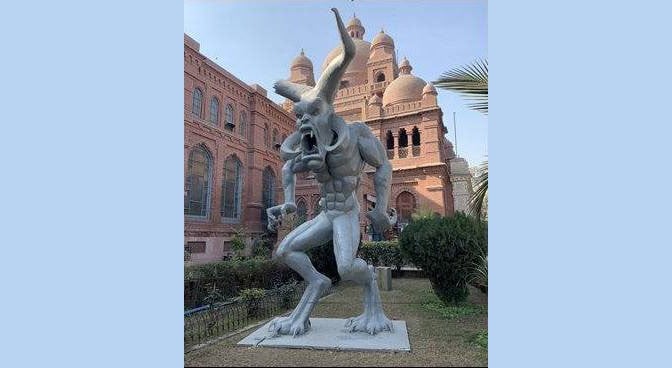
A giant sculpture of what some people interpreted as Satan, was recently placed outside the Lahore Museum. The varied public response soon forced the authorities to cover it and, eventually, truck it away

A huge, hulking sculpture was placed outside the Lahore Museum a few days ago.
Interestingly, the figure, which some interpreted as Satan while others said was replicated in giant form a cartoon character known as ‘Dirtoo,’ has now been trucked away.
The 20-foot statue had created controversy after a petition was moved in the Lahore High Court by a citizen stating that the creation by Irbaat ul Hassan, a fine arts student at Punjab University, scared children and was unaesthetic to look at, particularly in the premises of the refined, colonial-era Lahore Museum building.
The debate raging on the social media has involved the question of whether anybody has the right to judge whether a piece of art is ugly or beautiful; worthy of looking at or not deserving of a place in a public setting. Tweets and Facebook posts have differed strongly in their opinion. Some are delighted that the art piece has been banished, calling it ‘shaitaan-like’; others argue that every artist has the right to create a piece of art that fits in with their view of the world.
A mother who had taken her children to the museum said, "My three-year-old and even the older children were simply terrified, and refused to go inside [the museum]. So, we wasted all that time. Why should such a scary object be put there, in the first place?"
Renowned artist and art critic Quddus Mirza says, "The [said] sculpture was displeasing to look at. It would be more fitting to have placed it outside a playworld or any such place."
He does, however, agree that sculpture as a form of art has always remained controversial in Pakistan, as it can attempt to replicate the human image. Some of the best known pieces of sculpture such as the giant figure of David created by Michelangelo or the Pieta by the same artist are renowned for their majesty and sheer beauty brought to the pieces of marble.
Sculpture has become increasingly unacceptable in Pakistan, notably since General Zia’s Islamisation in the 1980s when even the paintings that depicted the human figure, and especially the nudes, were banned. The late Colin David’s private exhibitions (of nudes) were vandalised several times, allegedly by the Jamiat proponents.
Mirza suggests that sculpture should be reintroduced to a strictly conservative society by "putting up figures of well-known personalities at different spots in major cities." He says that no one would object if a sculpture depicting the Quaid-e-Azam, for instance, was placed in a public place, or that of his sister, Fatima Jinnah.
Mirza believes that this could be the starting point for getting sculpture back into our lives and telling the world about the incredible beauty that can be created by a talented individual working on his material with a chisel, hammer, or other tools to carve out beautiful forms.
He adds that the controversial structure placed outside the Lahore Museum simply did not fit in with any definition of aesthetic beauty, and was not a pleasant sight.
The controversy raises an interesting question. It is not known who gave permission for the massive structure to be placed outside the museum, apparently for exhibition. TNS tried to contact the authorities but they could not be reached.
The fact remains that such matters need to be well thought out. Irbaat ul Hassan has himself gone on record to say that he was working on the subject of ferocity, and his artwork was intended to convey the difference between man and animal, who could not self-reflect.
Art covers a huge sphere of ideas and thoughts. Many would argue the creations of US artist Andrew Warhol, with his soup-tin structures, were not art at all; others disagree strongly. The debate will no doubt continue; the arguments will rage on on the social media and elsewhere, but we can only hope as they continue, a broader acceptance for various kinds of art will emerge and one day sculpture, along with all other art forms, will re-enter the lives of the common people.